Folic Acid-Adorned Curcumin-Loaded Iron Oxide Nanoparticles for Cervical Cancer
- PMID: 35201760
- PMCID: PMC8941513
- DOI: 10.1021/acsabm.1c01311
Folic Acid-Adorned Curcumin-Loaded Iron Oxide Nanoparticles for Cervical Cancer
Erratum in
-
Correction to "Folic Acid-Adorned Curcumin-Loaded Iron Oxide Nanoparticles for Cervical Cancer".ACS Appl Bio Mater. 2023 Feb 20;6(2):932. doi: 10.1021/acsabm.2c01014. Epub 2023 Jan 9. ACS Appl Bio Mater. 2023. PMID: 36622897 Free PMC article. No abstract available.
Abstract
Cancer is a deadly disease that has long plagued humans and has become more prevalent in recent years. The common treatment modalities for this disease have always faced many problems and complications, and this has led to the discovery of strategies for cancer diagnosis and treatment. The use of magnetic nanoparticles in the past two decades has had a significant impact on this. One of the objectives of the present study is to introduce the special properties of these nanoparticles and how they are structured to load and transport drugs to tumors. In this study, iron oxide (Fe3O4) nanoparticles with 6 nm sizes were coated with hyperbranched polyglycerol (HPG) and folic acid (FA). The functionalized nanoparticles (10-20 nm) were less likely to aggregate compared to non-functionalized nanoparticles. HPG@Fe3O4 and FA@HPG@Fe3O4 nanoparticles were compared in drug loading procedures with curcumin. HPG@Fe3O4 and FA@HPG@Fe3O4 nanoparticles' maximal drug-loading capacities were determined to be 82 and 88%, respectively. HeLa cells and mouse L929 fibroblasts treated with nanoparticles took up more FA@HPG@Fe3O4 nanoparticles than HPG@Fe3O4 nanoparticles. The FA@HPG@Fe3O4 nanoparticles produced in the current investigation have potential as anticancer drug delivery systems. For the purpose of diagnosis, incubation of HeLa cells with nanoparticles decreased MRI signal enhancement's percentage and the largest alteration was observed after incubation with FA@HPG@Fe3O4 nanoparticles.
Keywords: MRI; cervical cancer therapy; curcumin; iron oxide nanoparticles; polyglycerol; targeted delivery.
Conflict of interest statement
The authors declare no competing financial interest.
Figures

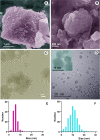

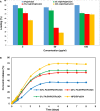

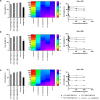
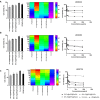
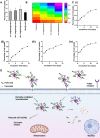

Similar articles
-
Investigation of Folate-Functionalized Magnetic-Gold Nanoparticles Based Targeted Drug Delivery for Liver: In Vitro, In Vivo and Docking Studies.ACS Biomater Sci Eng. 2024 Oct 14;10(10):6299-6313. doi: 10.1021/acsbiomaterials.4c01039. Epub 2024 Sep 2. ACS Biomater Sci Eng. 2024. PMID: 39221994
-
Functionalization of Magnetic Nanoparticles by Folate as Potential MRI Contrast Agent for Breast Cancer Diagnostics.Molecules. 2020 Sep 4;25(18):4053. doi: 10.3390/molecules25184053. Molecules. 2020. PMID: 32899812 Free PMC article.
-
Folic acid-decorated PEGylated magnetite nanoparticles as efficient drug carriers to tumor cells overexpressing folic acid receptor.Int J Pharm. 2022 Sep 25;625:122064. doi: 10.1016/j.ijpharm.2022.122064. Epub 2022 Aug 8. Int J Pharm. 2022. PMID: 35952802
-
Folic acid decorated magnetic nanosponge: An efficient nanosystem for targeted curcumin delivery and magnetic resonance imaging.J Colloid Interface Sci. 2019 Nov 15;556:128-139. doi: 10.1016/j.jcis.2019.08.046. Epub 2019 Aug 13. J Colloid Interface Sci. 2019. PMID: 31437658
-
pH sensitive core-shell magnetic nanoparticles for targeted drug delivery in cancer therapy.Rom J Morphol Embryol. 2016;57(1):23-32. Rom J Morphol Embryol. 2016. PMID: 27151685 Review.
Cited by
-
Advances in lysosomal escape mechanisms for gynecological cancer nano-therapeutics.J Pharm Anal. 2024 Dec;14(12):101119. doi: 10.1016/j.jpha.2024.101119. Epub 2024 Oct 15. J Pharm Anal. 2024. PMID: 39811489 Free PMC article. Review.
-
(Nano)platforms in bladder cancer therapy: Challenges and opportunities.Bioeng Transl Med. 2022 Jun 17;8(1):e10353. doi: 10.1002/btm2.10353. eCollection 2023 Jan. Bioeng Transl Med. 2022. PMID: 36684065 Free PMC article. Review.
-
Microneedle-mediated nanomedicine to enhance therapeutic and diagnostic efficacy.Nano Converg. 2024 Apr 18;11(1):15. doi: 10.1186/s40580-024-00421-w. Nano Converg. 2024. PMID: 38634994 Free PMC article. Review.
-
Folate-Modified Curcumin-Loaded Nanoparticles for Overcoming Delivery Challenges in Cancer Treatment: A Narrative Review.Curr Pharm Biotechnol. 2025;26(10):1423-1440. doi: 10.2174/0113892010299290240531101441. Curr Pharm Biotechnol. 2025. PMID: 38918979 Review.
-
Electrospinning Preparation, Structure, and Properties of Fe3O4/Tb(acac)3phen/Polystyrene Bifunctional Microfibers.Materials (Basel). 2023 Jun 15;16(12):4409. doi: 10.3390/ma16124409. Materials (Basel). 2023. PMID: 37374592 Free PMC article.
References
-
- Paskeh M. D. A.; Mirzaei S.; Gholami M. H.; Zarrabi A.; Zabolian A.; Hashemi M.; Hushmandi K.; Ashrafizadeh M.; Aref A. R.; Samarghandian S. Cervical cancer progression is regulated by SOX transcription factors: Revealing signaling networks and therapeutic strategies. Biomed. Pharmacother. 2021, 144, 112335.10.1016/j.biopha.2021.112335. - DOI - PubMed
MeSH terms
Substances
LinkOut - more resources
Full Text Sources
Medical
Miscellaneous

